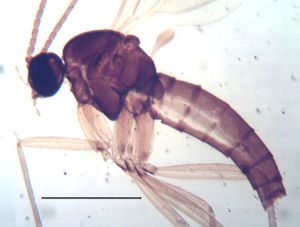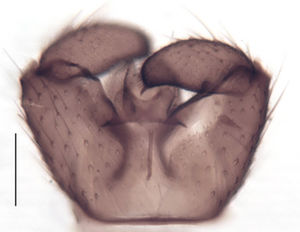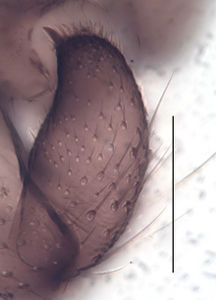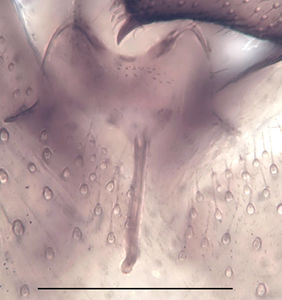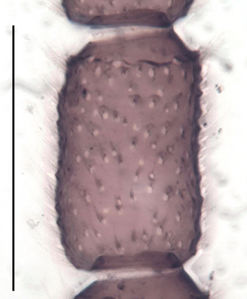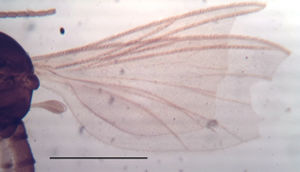Trichosiopsis subcoarctata
Ordo: Diptera
Familia: Sciaridae
Genus: Trichosiopsis
Name
Trichosiopsis subcoarctata Mohrig & Menzel, 1997 – Wikispecies link – ZooBank link
- Leptosciarella (Leptosciarella) subcoarctata Mohrig & Menzel, 1997[1]: 57–58, fig. 7
Type material
Holotype ♂, in PWMP 3165, leg. Krivosheina, 24.06.1974.
Type locality
Russia, Tuva, Shagonar
Description (male)
Head. Eye bridge 4–5 rows of facets. Antenna unicolour. LW-index of 4th flagellomere 1.4–1.6; neck 0.2–0.3 × segment width; transition of basal part to neck pronounced. Colour of neck unicolour. Antennal setae as long as segment width; of normal strength; dense; salient. Palpus darkened; of normal length; palpomeres 3. First palpomere elongate; with 5–7 setae; with only sparse sensilla. Second palpomere elongate. Third palpomere as long as first. Thorax. Colour brown. Notum unicolour. Thoracic setae normal, or weak; brown, or white. Posterior pronotum bare. Mesothoracic sclerites bare. Legs. Colour yellow. Hind coxa of same colour as femora. Setae on front coxa pale. Front tibial organ as patch of setae; dark; front tibial organ not bordered. Tibial setae on hind legs normal, shorter than tibial width. Tibial spurs of equal length. Claws untoothed. Wing. Wing slightly darkened; of normal shape. Wing membrane without macrotrichia. Wing venation weak, with faint stM. M-fork of normal shape. R1 ending at or slightly before base of m-fork; posterior veins with macrotrichia; stM mostly with macrotrichia; CuA1 and CuA2 mostly with macrotrichia; bM bare; r-m mostly setose; bM:r-M 0.5–1; st-Cu:bM 0.3–0.5; R1:R 1.2–1.5. Halter darkened; of normal length. Abdomen. Abdominal setae strong; dense; on tergites white; on sternites white. Hypopygium concolour with abdomen; LW-index 0.52–0.72. Base of gonocoxites with weak setae; gonocoxites broadly separated; inner margin of gonocoxites narrowly U-shaped, or V-shaped; inner membrane of hypopygium scarcely setose; ventral margin of gonocoxite with short setae. Gonostylus elongate; LW-index 2.05–2.3; Inner margin straight, or concave; apex equally rounded. Apical tooth present; without internal structure; of medium strength; LW-Index 2–2.4. Awl-like setae normal; present beneath apical tooth. Megasetae absent. Whiplash-hair absent. Tegmen 0.5–0.7 × longer than broad; rectangular with rounded edges, or of unusual shape; without special features; central process absent. Length of ejaculatory apodeme/hypopygium 28–36 %; base of ejaculatory apodeme present. Field with aedeagal teeth inconspicuous. Measurements. Body size 2.9–3.4 mm. Hind tibia 1.6–1.75 mm. Wing length 2.6–3.4 mm.
Diagnosis and discussion
Trichosiopsis subcoarctata is a medium sized species, which is recognizable by its completely bright abdominal and thoracal setae and yellow legs. Completely bright setae are otherwise only present in Trichosiopsis hispida and some related species, which can be distinguished by the setae on the laterotergite and more tapered gonostyli. Contrary to the indication from the species name, Tr. subcoarctata is not closely related to Tr. coarctata or other species of the Tr. trochanterata complex, but belongs to a different complex of very similar species, the Tr. subcoarctata complex. Species of this complex share the bright body hairs and completely yellow legs. The gonostylus is equally rounded and the tegmen is apically depressed in a saddle-like manner and has roundly bordered edges. The other members of this complex are Trichosiopsis indistincta, Trichosiopsis neoindistincta and Trichosiopsis transatlantica. Tr. subcoarctata differs from all these species by shorter antennae and a bare posterior pronotum.
Etymology
The species name refers to the similarity with Trichosiopsis coarctata.
Distribution
Russia[1].
Images
|
